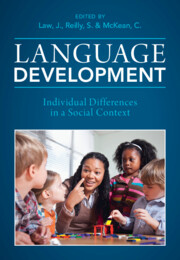Book contents
- Language Development
- Language Development
- Copyright page
- Contents
- Figures
- Tables
- Contributors
- A Tribute to Our Friend, Colleague and Fellow Editor, Professor James Law
- Introduction
- Part One Factors Influencing Language Development
- Part Two Continuity and Change
- 11 Language Trajectories in Childhood
- 12 Patterns of Language Development from Childhood to Adulthood and the Associated Long-term Psychosocial Outcomes
- 13 Social Inequalities in Vocabulary and the Role of Reading
- 14 The Dynamic Nature of Predictors and Outcomes in Children’s Language Development over Childhood
- Part Three Impact, Intervention and Equity
- Index
- References
11 - Language Trajectories in Childhood
The Nature and Drivers of Individual Differences and Their Implications for Intervention
from Part Two - Continuity and Change
Published online by Cambridge University Press: 11 August 2022
- Language Development
- Language Development
- Copyright page
- Contents
- Figures
- Tables
- Contributors
- A Tribute to Our Friend, Colleague and Fellow Editor, Professor James Law
- Introduction
- Part One Factors Influencing Language Development
- Part Two Continuity and Change
- 11 Language Trajectories in Childhood
- 12 Patterns of Language Development from Childhood to Adulthood and the Associated Long-term Psychosocial Outcomes
- 13 Social Inequalities in Vocabulary and the Role of Reading
- 14 The Dynamic Nature of Predictors and Outcomes in Children’s Language Development over Childhood
- Part Three Impact, Intervention and Equity
- Index
- References
Summary
Whilst child language research has a long history of the examination of developmental change, it is only relatively recently that research methods have been employed that allow us to understand the nature and drivers of individual differences in child language development across a population. This chapter presents findings from studies examining children’s language trajectories from early childhood to adolescence using data from epidemiological studies in which large, population-ascertained samples are followed prospectively. Findings from studies using epidemiological methods to examine individual differences in child language trajectories are identified, and how these findings can inform public health models of intervention, considering primary, secondary and tertiary prevention, is considered. First, the implications for the design of services for pre-school children (0–4 years) is considered. Key learning points to methods for targeting interventions and the identification of potential levers for language growth which could be harnessed for preventative intervention. The chapter then turns to language trajectories in school-age children (here 4–11 years) and discusses the identification of those most in need of additional support and examines what intervention and trajectory research together tell us about the best targets for interventions. Recommendations for services and priorities for research are then identified.
Keywords
- Type
- Chapter
- Information
- Language DevelopmentIndividual Differences in a Social Context, pp. 259 - 280Publisher: Cambridge University PressPrint publication year: 2022
References
- 2
- Cited by

